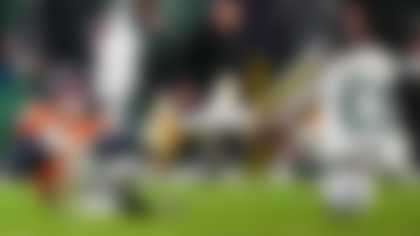The NFL has announced an initiative with General Electric, known as the GE-NFL Head Health Challenge. It will be a partnership to help bring more insights about health and safety to the game, including expanded research for head injuries.
For more details, go to this website: NFLGEbrainchallenge.com.
Below is the official press release for the partnership between the NFL and General Electric:
GE, NFL & LEADING HEALTHCARE EXPERTS TEAM UP TO ACCELERATE CONCUSSION RESEARCH, DIAGNOSIS & TREATMENT
$40 million research program aims to increase accuracy of traumatic brain injury diagnosis
GE, NFL, Under Armour also launch $20 million open innovation challenge to find and fund ideas to develop new solutions to diagnose and protect against traumatic brain injury
NEW YORK, March 11, 2013 -- (NYSE: GE) -- GE and the NFL today announced the Head Health Initiative, a four-year, $60 million collaboration to speed diagnosis and improve treatment for mild traumatic brain injury. The goal of the research and innovation program, guided by healthcare experts, is to improve the safety of athletes, members of the military and society overall.
The initiative includes a four-year, $40 million research and development program to evaluate and develop next generation imaging technologies to improve diagnosis that would allow for targeting treatment therapy for patients with mild traumatic brain injury. In addition the NFL, GE and Under Armour launched a two-year open innovation challenge to invest up to $20 million in research and technology to better understand, diagnose and protect against mild traumatic brain injury.
GE Chairman and CEO Jeff Immelt said, "GE is a leader in developing sophisticated diagnostic imaging technology, but for all the advances in science our knowledge of the brain is far behind that of nearly every other organ in the body. With this initiative, we will advance our research and apply our learning to sports-related concussions, brain injuries suffered by members of the military and neurodegenerative diseases such as Alzheimer's and Parkinson's. Advancing brain science will help families everywhere."
NFL Commissioner Roger Goodell said, "Jeff and I have had many conversations over the years about business and the game we both love -- football. The future of our great game is bright. The NFL has made tremendous progress in making the game safer and more exciting. But we know we have more work to do. Our collaboration with GE and Under Armour and the launch of the innovation challenges puts us on an accelerated path to progress with experienced scientists, academics and entrepreneurs dedicated to developing game-changing technologies that will benefit athletes, the military and all members of society."
Research to Map Brain Imaging Biomarkers
The research will take a whole brain approach to determine the key Magnetic Resonance Imaging (MRI) biomarkers for potential diagnosis, outcome prediction, and therapy management for patients with mild traumatic brain injury. The research study will be guided by an advisory board consisting of a cross-disciplinary team of medical professionals from various institutions. Among those participating:
- Dr. Thomas McAllister is the Millennium Professor of Psychiatry and Neurology, Director of the Section of Neuropsychiatry and Vice Chair for Neuroscience Research for the Department of Psychiatry at the Geisel School of Medicine at Dartmouth. He has recently been named chair of the Department of Psychiatry and the Albert Eugene Sterne Professor of Clinical Psychiatry at Indiana University School of Medicine. He will begin his duties in the summer of 2013.
- Dr. Richard Ellenbogen is the Theodore S. Roberts Endowed Professor and Chairman of the Department of Neurological Surgery at The University of Washington. He is Co-Director of the Seattle Concussion Program and is the co-chair of the NFL Head, Neck and Spine Committee.
- Dr. Russell Lonser is the Chair of The Ohio State University Wexner Medical Center Department of Neurological Surgery, head of the NFL's Research Subcommittee and a member of the NFL's Head, Neck and Spine Medical Committee.
- Dr. Geoffrey Manley is the Chief of Neurosurgery at San Francisco General Hospital and Professor of Neurosurgery at the University of California San Francisco (UCSF).
- Dr. Pratik Mukherjee is an Attending Neuroradiologist and an Associate Professor of Radiology and Biomedical Imaging, Bioengineering and Therapeutic at the University of California San Francisco (UCSF).
- Lieutenant Colonel Gerald York, is an Active Duty radiologist with a Certificate of Added Qualification (CAQ) in neuroradiology serving at Brooke Army Medical Center in Houston, TX. He has expertise in interpretation of CT and MRI of the brain, spinal cord, and head-neck disorders, including many acute, subacute and chronic traumatic brain injury patients.
- Colonel Jamie Grimes is the National Director of the Defense and Veterans Brain Injury Center. As national director, COL Grimes oversees all aspects of the organization's mission: to serve active duty military and veterans with traumatic brain injury through state-of-the-art medical care and care coordination and through innovative clinical research and educational programs.
- Dr. Larry Leverenz is the Clinical Professor in the Department of Health and Kinesiology and Director of Athletic Training Education at Purdue University. He has served professionally as a member of the National Athletic Trainers' Association Education Council and as president of the Commission on Accreditation of Allied Health Education Programs. Currently, he is the President of the World Federation of Athletic Training & Therapy.
- Dr. Teena Shetty is a Neurologist at Hospital for Special Surgery and is triple board-certified in neurology, neuromuscular medicine, and electrodiagnostic medicine.
- Dr. Brian Hainline is the Chief Medical Officer at the NCAA. He is a leading sports medicine advocate with more than two decades' experience most recently as the chief medical officer of the United States Tennis Association (USTA).
Open Innovation Challenge to Study and Prevent Traumatic Brain Injury
In addition to the research program, the NFL is partnering with GE and Under Armour to launch the Head Health Challenge, which has two focus areas that seek new solutions for understanding mild traumatic brain injury. The organizations are pledging to find and fund ideas that accelerate solutions for brain protection. The challenge fund could invest up to $20 million.
Sue Siegel, CEO of GE healthymagination, said, "GE is investing in research and development to fast-track advancement in head health. Through our research collaboration and open innovation challenge, we hope to stimulate the broader ecosystem of scientists, engineers, mathematicians, computer scientists, entrepreneurs, and innovators worldwide to bring their talents to this effort and accelerate the current understanding of brain trauma and improve diagnostic tools."
Kevin Plank, founder and CEO of Under Armour said, "As longstanding partners of the NFL, we recognize the magnitude of this initiative, and the impact it will have for athletes at all levels. Under Armour was founded upon the pillar of making all athletes better through the relentless pursuit of innovation. We take great pride in supporting this effort to reward new ideas and breakthrough concepts in this space, particularly as it applies to protecting athletes and influencing positive change in sports."
Dr. Geoff Manley, professor and vice-chair of the Department of Neurological Surgery at UCSF and Chief of Neurotrauma at San Francisco General Hospital, said, "Traumatic brain injury is one of the greatest unmet medical needs of our time. Every 20 seconds someone in the United States sustains a brain injury. A better understanding of the molecular, physiological, and behavioral/biomechanical changes that occur shortly after a traumatic event is needed to reliably diagnose the types of changes that are difficult to identify using current technologies."
Challenge I: Methods for Diagnosis and Prognosis of Mild Traumatic Brain Injuries
Starting today, GE and the NFL are inviting proposals for technologies and imaging biomarkers that address identification and management of subclinical and mild traumatic brain injury. Multiple cash awards with a cumulative total value of up to $10 million will be made, along with the possibility of future partnership and collaboration with GE. Entries are being immediately accepted at www.NFLGEBrainChallenge.com. Specific focus areas for this challenge include:
- Development and validation of imaging and/or sensor based biomarkers that can aid in the diagnosis and prognosis of mild traumatic brain injury events. These include imaging biomarkers of brain structure, connectivity, function, cognition, neuroinflammation, and molecular markers.
- Development of new technologies that are more sensitive to small contusions and injuries that are missed by current technologies; and assessing the long-term chronic impact of these events.
- Improved algorithms for the quantification and visualization of markers of brain injury severity and longitudinal change.
- Algorithms and tools that link imaging data to clinical, cognitive, and biomechanical data.
- Models of individual risk and long-term prognosis and clinical decision support tools using population studies.
- Robust methods for triaging acute stage events and developing "Return to Play" guidelines using physiological, molecular, electrical or physical changes in brain or body functions.
Challenge II: The Mechanics of Injury: Innovative Approaches For Preventing And Identifying Brain Injuries
Launching in fall 2013, the NFL, Under Armour and GE will invite proposals for new materials and technologies that can protect the brain from traumatic injury and new tools for tracking head impacts in real time. Specific focus areas for this challenge include, but are not limited to:
Protection against Injury
- Materials or devices that can distribute the force of impact. Smart materials or active polymers that are comfortable but can adapt to sudden impacts are highly desirable
- Systems to predict and initiate protective responses to prevent injury activation of adaptive padding at the focus of impact
Monitoring and Identifying Injury
- Systems that monitor and integrate directional and rotational impact forces. These systems should integrate information with imaging/diagnostic equipment
- Sensors to provide biofeedback to modify behaviors that predispose athletes to injury
- Systems that monitor biomechanical and physiological responses to detect injury
- Systems to efficiently collect, interpret and organize large quantities of real-time data
The winners of the challenges will be selected by a panel of external judges that include leading healthcare experts in brain research, imaging technologies, and advocates for advances in brain research. For Challenge I these individuals include:
- Dr. William J. Heetderks is the Director of Extramural Science Programs at the National Institute of Biomedical Imaging and Bioengineering (NIBIB), NIH.
- Dr. Walter Koroshetz is the Deputy Director of the National Institute of Neurological Disorders and Stroke (NINDS) at the NIH. Before joining NINDS, Dr. Koroshetz served as vice chair of the neurology service and director of stroke and neurointensive care services at Massachusetts General Hospital (MGH).
- General Peter Chiarelli, USA (Ret.) is the Chief Executive Officer of One Mind for Research. He is a retired four-star General with 40 years of experience designing and implementing American defense policy for the U.S. Army and Department of Defense in peace and during combat operations.
- Colonel Dallas Hack is the Director of the Combat Casualty Care Research Program and the Chair, Joint Program Committee 6 (Combat Casualty Care), US Army Medical Research and Materiel Command, Ft Detrick, MD, where he coordinates leading edge research focused on new techniques and products to save the lives and reduce morbidity of troops injured in the line of duty.
- Dr. Geoff Manley is the Chief of Neurosurgery at San Francisco General Hospital and Professor of Neurosurgery at the University of California San Francisco (UCSF).
-- NFL Communications



